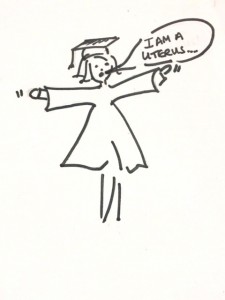Graduation: swirling graduates’ gowns gather in the grounds of a cathedral. A student presented me to her mother saying she remembered everything I had taught her. I gently teased her, at which point she flung her arms out wide and waggled her fingers gently, repeating words I said two years previously: “I AM A UTERUS!! Here are the fimbriae, wafting the egg into the fallopian tubes…”
 Peer observation of teaching practice is deemed good practice for novice and experienced lecturers. An alternative is self-coaching via videoing teaching practice with Panopto. This may be as part of the PGCert, TeachBU or appraisal but regular reflection is the greatest benefit of the process.
Peer observation of teaching practice is deemed good practice for novice and experienced lecturers. An alternative is self-coaching via videoing teaching practice with Panopto. This may be as part of the PGCert, TeachBU or appraisal but regular reflection is the greatest benefit of the process.
I came to videoed self-coaching by accident. I was analysing research videos of a Drawing Programme that I had facilitated. Though I watched participants through my “researcher” lenses I became distracted by my on-screen presence. I was scrutinising myself through my “lecturer” and “coach” lenses. I irritated myself due to expansive gesturing while explaining processes.
Concurrently, I conducted a mid-unit evaluation on a module I was teaching. The following week, I presented the results and added that viewing research video data made me aware of how much I moved my arms during teaching. I apologised and said I would attempt to change this habit. As I wandered round during learning activities, several students requested that I DID NOT STOP using my body to explain concepts. Students reiterated several examples of how altering physical positions, which I did without much conscious awareness, helped reinforce concepts. My facial and bodily gestures were drawings-in-the-air that punctuated speech. They explained how these performative enactments conveyed different notions than speech alone which they valued for learning.
Videoing teaching situations are easier than before but I would advocate sharing self-appraisals with colleagues and students as they may see things differently to you.








